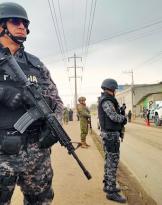Professor Shaul Shay (IDF Reserve) is the Director of Research at the Insitute for Strategy and Policy at The Interdisciplinary Center in Herzliya in Israel and served as the Deputy Head of the Israeli national security council. We’re honored to have an exclusive interview of him about his new book. Among his published books are: The Shahids, Islam and suicide attacks, Islamic Terror and Balkans.
Professor Shay, on January 1st your new book entitled “Israel and Terror Abductions (1986 – 2016)” came out, edited by Sussex-academic and available on Amazon, too. Basically, the book analyzes the challenges that the Islamic groups pose and the response of Israel relating to abductions in Lebanon via the Hezbollah organization (1983- 2016) and in Israel via Hamas movement (1989- 2016). What are these challenges?
The matter of the release and/or return of the Israeli POWs, MIAs and hostages is one of the most sensitive issues faced by Israeli society and its leadership. The sensitivity in this regard stems from several main reasons including the value of human life and personal freedom in the eyes of Israeli society; the religious aspect, namely the obligation to redeem prisoners; the religious and moral importance attributed to returning the bodies of Israeli civilians and soldiers for Jewish burial; the State’s moral obligation to preserve the life and safety of its citizens; and the obligation to protect IDF soldiers and members of the security forces who act on behalf of the State of Israel and fall captive into enemy hands. The principle of returning POWs, MIAs, kidnapped and fallen IDF personnel has been sacrosanct since the IDF's inception in 1948.
For the first few decades of its existence, Israel made exchanges with its Arab enemies of the sort contemplated by the Geneva Conventions following the cessation of each war. However, the rules of the game have since changed. Many of Israel's enemies are non-state actors such as Hezbollah and the Palestinian Hamas. These organizations operate outside the legal framework of the laws of war – routinely committing war crimes such as indiscriminate attacks (the deliberate targeting of civilians as such) and perfidy (disguising combatants as protected individuals such as civilians).

When Israel makes asymmetric prisoners swaps, it is only natural for Israel’s enemies to view the kidnapping of Israeli civilians and soldiers, and the violation of their legal rights in captivity, as an extremely profitable activity. For terrorist organizations, kidnapped Israeli soldiers and civilians are valuable and relatively cheaply-acquired bargaining chips to bring home their terrorists imprisoned in Israeli jails.
Do the kidnappings constitute a central component in the “attack repertoire” of a terror organization? What is their return?
In the 1980s Hezbollah began abducting Westerners and holding them hostage in order to bargain for the release of Shiites held in Israeli -and other countries- jails. Hezbollah turned the abduction of hostages (mainly of western origins) into a central bargaining tool to achieve political and military goals set by the organization and its patrons in Iran. Between 1982 and 1988, there were sixty-seven kidnapping incidents in Lebanon, Hezbollah was responsible for fifty-five of those kidnappings.
A central bone of contention in the prolonged conflict between Hezbollah and Israel is the issue of the captives. The Hezbollah grasps the sensitivity of Israeli society and of its decision-makers vis-à-vis its civilians and soldiers. Therefore, the abduction of soldiers has become a central target within the organization’s modus operandi. The hostages became a “strategic asset” which the organization exploits to promote its goals in the conflict with Israel and to strengthen its position in Lebanon and the Arab world.
The kidnappings of Israelis began in late 60s as attempts to ransom prisoners. On April 17 every year, Palestinians commemorate "Prisoners Day". Given the importance of the prisoners for Palestinian society, there is no doubt that the kidnapping of an Israeli soldier is of strategic value for all Palestinian terror organizations.
Since the Islamic Resistance Movement (Hamas) was founded in 1987, the movement has kidnapped more than 20 Israeli soldiers and settlers, but not all of them reached the stage of carrying out an exchange deal. It appears that over the years Hamas has been systematically engaging in the abduction doctrine. This while improving and honing its operative aspects pursuant to the lessons learned from actual abductions and attempted abductions, expending efforts to introduce this combat doctrine into the consciousness of the activists and motivating them to act when the need arises.
Hamas has published several versions of "Field Manuals for Kidnapping" that provide practical and doctrinal information for carrying out attacks. The book deals extensively with the subject of the abduction of Israelis as a means to securing the release of Palestinian prisoners from Israeli prisons.
What is the response of Israel relating to abductions?
As a rule, when Israel had the opportunity to release hostages or captives through a military operation without succumbing to the terrorists’ demands, the decision makers preferred this alternative. In other cases, when a military operation was not an option, Israel generally demonstrated flexibility (“flexible policy”) and endeavored to bring about the hostages’ release via negotiations, meeting the terror organizations’ demands either partially or fully.

In October 2011, Prime Minister , Binjamin Netanyahu when explaining how he could sign the agreement that marked a new record of acquiescence to a terrorist organization — the release of 1,027 prisoners, many of them with Israeli “blood on their hands” he said “We had no choice.”
Netanyahu would have been happy to try and rescue Shalit in a military operation, if that would have been possible, but the intelligence community could not locate Shalit. In the end, the question was whether to leave Shalit rotting in a pit in the Hamas prison or to take a bold decision. That’s what Netanyahu did. As Israel agreed the terms of the swap of Gilad Shalit, Prime Minister Benjamin Netanyahu ascribed the asymmetry in numbers to the ethical teachings of Judaism. “The nation of Israel is a unique people,” he told the cabinet.
Do the released terrorists return to terrorist activity?
The answer is that the most troubling, long-term consequence of such exchanges is the fact that many of the terrorists released return to committing terrorism and related offences but this is just one part of the problem.
For hostage events, the conventional wisdom is that past concessions to terrorists encourage additional seizures owing to terrorists’ updated priors of high payoffs. If, instead, terrorists know beforehand that they have nothing to gain from hostage taking due to a government’s announced no-concession stance, then they will never abduct hostages. Thus, many governments — including the United States — have adopted a no-concession policy in the hopes of reducing hostage taking.
Releasing convicted terrorists undermines the criminal justice system. It is unjust to release individuals who have committed serious crimes before they have served their sentences. In addition, such releases are likely to provide comfort to terrorists planning future attacks, who can hope that if caught and convicted, they will one day be exchanged for kidnapped Israelis.
 Israel could potentially declare that from now on, there will be no more negotiations. The problem is that this is easier said than done, and the government will have difficulty explaining to the family of the next soldier why it is not willing to negotiate the release of their son. There is no easy answer, but with Israeli intelligence warning of increased motivation among terrorist groups to kidnap soldiers, a clear policy is needed.
Israel could potentially declare that from now on, there will be no more negotiations. The problem is that this is easier said than done, and the government will have difficulty explaining to the family of the next soldier why it is not willing to negotiate the release of their son. There is no easy answer, but with Israeli intelligence warning of increased motivation among terrorist groups to kidnap soldiers, a clear policy is needed.
On 12th june 2014 three Israeli kidnapped teenagers were murdered and their bodies were found on 30th june 2014. On 6th january 2015 Hussam Qawasmeh, a member of Hamas was jailed and sentenced for the murder and sentenced to pay 63.000 dollars in compensation to the victims’ families. Professor Shay , how come the three teenagers had been murdered when if alive, some Palestinians prisoners could have been released in return?
Naftali Fraenkel and Gilad Shaar, both 16, and EyalYifrach, 19, were abducted June 12, 2014, while hitchhiking home from their religious schools in the West Bank.Israeli Prime Minister Benjamin Netanyahu blamed Hamas for abducting three teenagers who went missing in Jewish settlements in the West Bank. A Hamas spokesman in Gaza said that Netanyahu's comments attributing blame were "stupid and baseless". Therefore there was no negotiation with Hamas.
After an 18-day search, their bodies were found buried under rubble in a field not far from where they had been kidnapped. Israeli police say they probably were shot within minutes of being bundled into a stolen car.
After the bodies of the Israeli teenagers were found, Saleh Arouri, a senior leader of Hamas, boasted at a conference in Turkey that the group’s military wing was behind the “heroic action. It was an operation by your brothers from the al-Qassam Brigades,” Arouri said, adding that Hamas hoped to use the Israeli teens in a trade for Palestinians held in Israeli jails.
After the death of the kidnappers, Salah Bardawil, a Hamas spokesman in Gaza, said the group “mourns the two martyrs . . . who were murdered by the Zionists.” He said the deaths of the two Palestinians would not have occurred without help from Palestinian Authority security forces in the West Bank, assistance that Hamas deplores as collaborating with the enemy.
Israel’s crackdown in the West Bank prompted outcries of collective punishment as thousands of homes were searched, 400 Palestinians — including many of Hamas’s top leaders — were arrested, and five were killed while hurling stones at soldiers or otherwise confronting them.
Israeli forces on September 23, 2014, shot and killed two Hamas operatives suspected of kidnapping and killing three Israeli teenagers in June 2014. Another Hamas member, Hussam Kawasmeh, Marwan Kawasmeh’s uncle, was charged by Israel in September 2014 with organizing and funding the kidnapping.
(foto: Israel Defense Forces)












